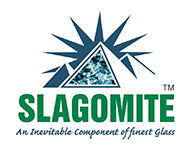

Perhaps the most dramatic benefit from the use of Slagomite is the virtual elimination of seeds and blisters caused by excessive residual sulfate. Even at low levels of Slagomite , the reduction of seeds is dramatic and immediate. Not only is there a reduction in overall seed count but the variability is also reduced giving a more consistent product quality. Figure 4.1 shows the 66% reduction in seed count observed on addition of 13% Slagomite to a green container furnace. Figure 4.2 shows the 70% reduction in seeds observed when 6% Slagomite was added to a flint container furnace.

The combination of faster melting and lower temperature dissolution of silica grains when using Slagomite can result in a reduction in batch stones without the need to increase furnace temperature. Figure 4.3 shows how the implementation of Slagomite in a float furnace led to the virtual elimination of unmelted silica defects.

Slagomite is particularly valuable in the production of amber glass, or glass with an amber component to their color, such as dead leaf green or UVA green. The amber chromophore that produces the color in these glasses consists of reduced sulfur in the form of sulfide, S2-, combined with the oxidized form of iron, Fe3+. Slagomite can be used to control redox such that the reduced sulfur and oxidized iron can co-exist.

The reduction in furnace temperature that can be achieved while using Slagomite will reduce the level of refractory attack, directly reducing the number of defects, e.g. due to refractory run off. This reduced refractory wear will also have significant additional benefits in terms of extending furnace campaign life.

Slagomite is a weak reducing agent when compared to reducing agents such as carbon. As a result, comparatively large amounts of Slagomite are added to the recipe, resulting in more even distribution within the batch. In addition, the larger particle size of Slagomite compared to other reducing agents ensures the material is available to react over a longer period of time.